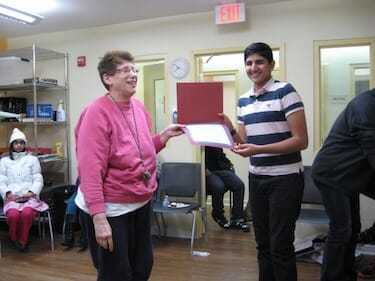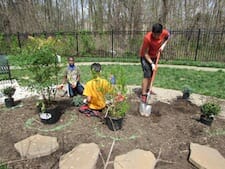How to Use the Energy of Young People to Get Adults Involved in the Community
This post is by Ryan Barton, resident services manager with the Community Preservation and Development Corporation in Alexandria, Va.
 Stony Brook residents participate in a computer class graduation ceremony.
Stony Brook residents participate in a computer class graduation ceremony.Two years ago, when I came to Stony Brook, a 204-unit, low-income apartment complex in Alexandria, Va., I noticed two things right away. First, adult community members were not engaged in programming and meetings, and second, there were a lot of youth. By a lot, I mean, a lot. Almost 50 percent of the residents were under 18 years old. They contained a boundless amount of energy and enthusiasm, but didn’t know how to channel that youthful excitement into action.
I dove into engaging residents immediately, but took the same worn path: I went door-to-door, speaking with adult residents, persuading them to join programs. We held town halls, hired contractors to run programs and held engagement events, but each had similar results: a handful of residents who found the programs and events only moderately useful. But when I held an event for youth, children were lined up outside the door. I decided to change my approach and focus on engaging a specific subset of residents: the young ones.
It started out small – passing out flyers, community trash clean-ups and teens tutoring younger kids. We had always run an introductory computer course, spending large amounts on a contractor who would routinely see classes of two or three residents. After a less-than-stellar computer course with only two graduates, I approached our teenage residents with an idea: teach a computer course to adult residents. I would provide snacks, help with lesson planning and would assist in recruiting residents.
 Stony Brook residents work on a landscaping project.
Stony Brook residents work on a landscaping project.The teens accepted hesitantly. None of them had ever taught anything, let alone a professional course with adults. But the results were spectacular.
Our first course had eight graduates learning basics in Word, Excel and PowerPoint. Pre- and post-tests showed enormous gains in knowledge, much more than any previous course. As many of our teens come from bilingual homes, they were able to teach and engage residents with little to no English speaking ability. Residents felt comfortable taking courses with other residents and people they knew.
A second course, this time with an advanced class for previous graduates, proved even more productive, with 13 graduates. The demand is now so high that the teen residents are planning on three separate courses, with a specialized course for residents with more advanced skills.
This activity branched off into a Zumba and yoga class led by teens, with two full classrooms of participants, as well as a community health initiative led entirely by teen residents. Our younger residents have even gotten into the action. Our youth who attend elementary school spent a school break turning a long abandoned plot of land into a community gathering garden, complete with an array of plants and a walking path, with future additions in the works.
The work of these youth has invigorated residents, and participation in adult programming is at an all-time high in our community. We plan on using this momentum to have adult residents begin running their own programming and meetings. But it was that youthful enthusiasm that started it all, enthusiasm that exists in every community, no matter the size or place.